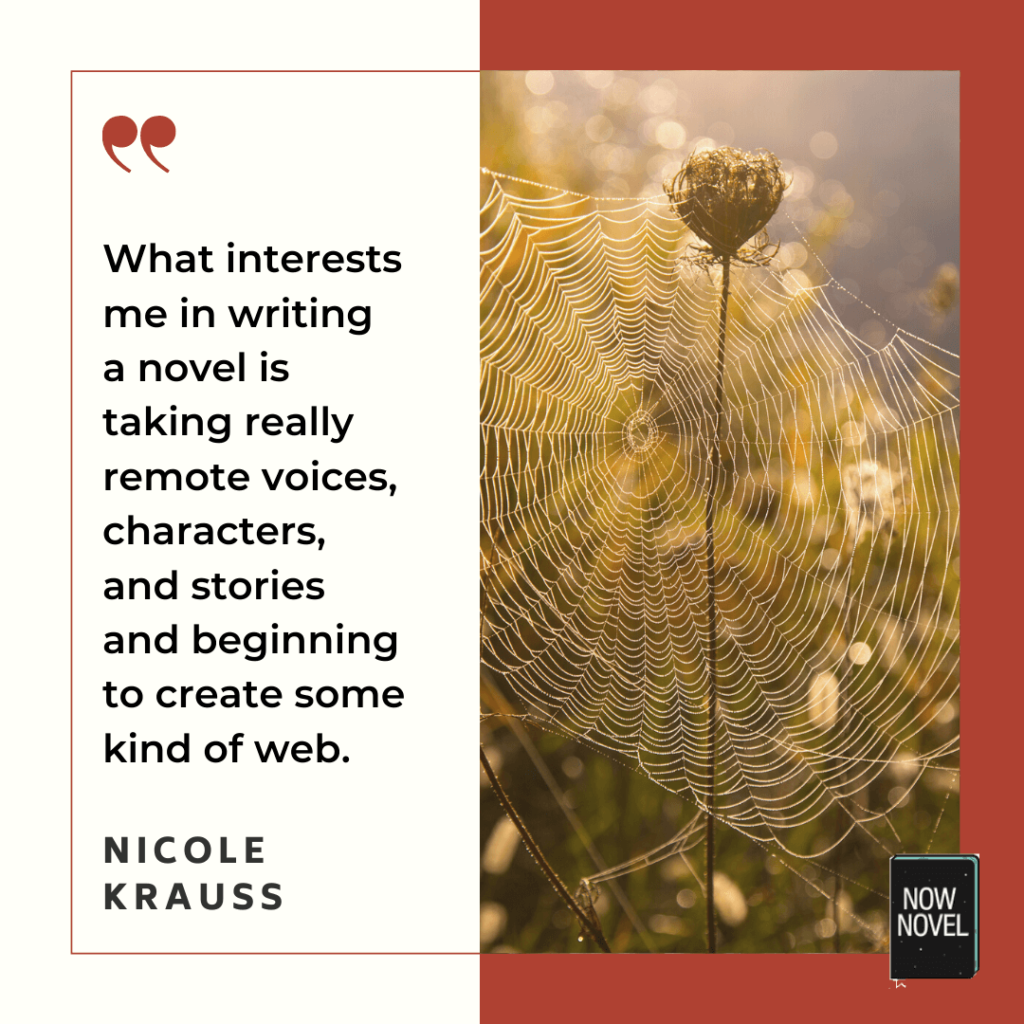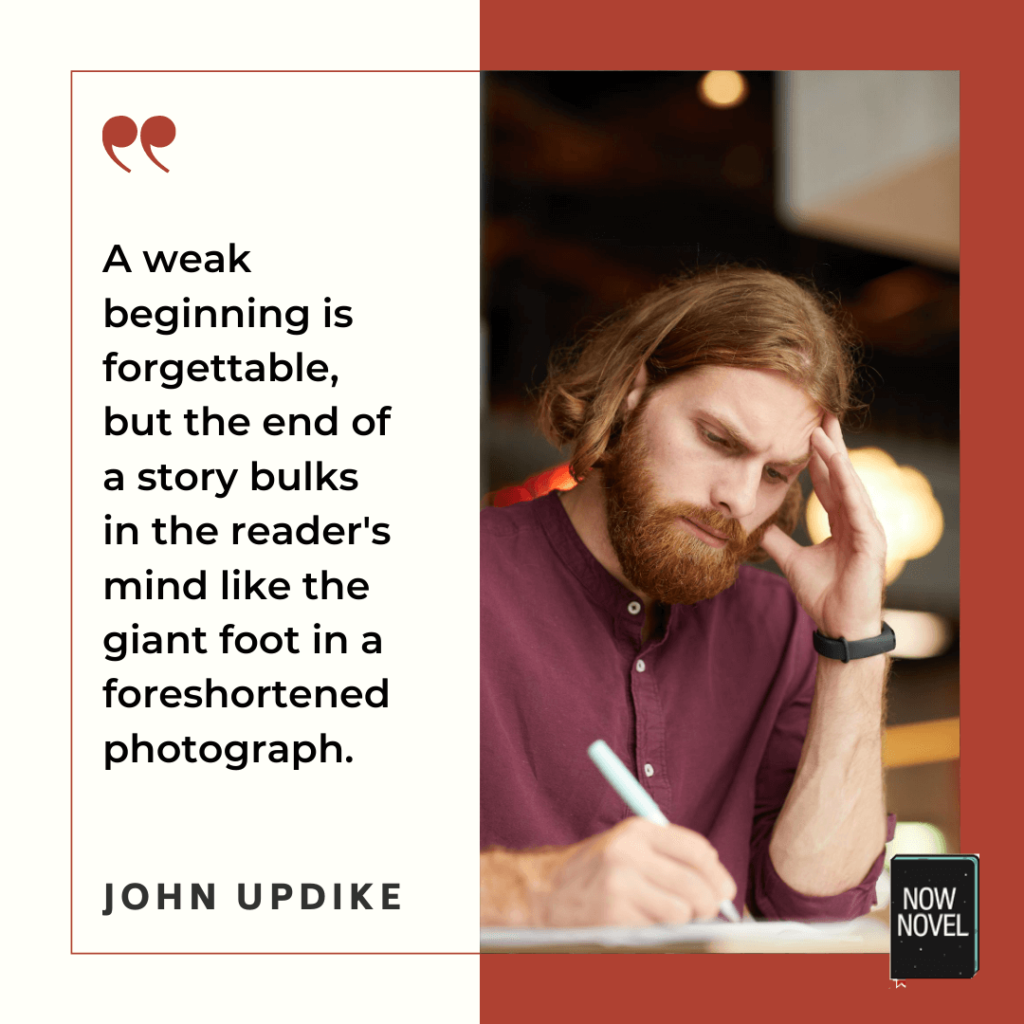How do you write story openings that engage readers from page one? We look at the beginning paragraphs of books Literary Hub listed as defining books of the 2000s. What do they reveal about writing strong beginnings?
10 insights from the openings of the 2000s’ defining novels:
- Share intriguing or defining character information
- Create a curious sense of place or event
- Start with surprising actions or scenes
- Create vivid details
- Build narrative suspense
- Play with story opening format or structure
- Start with a clear narrator’s voice
- Launch into engaging developments
- Establish mood and atmosphere
- Establish connections
Let’s read the examples along with the insights into how to start a book they share:
1. Share intriguing or defining character information
The first book in Emily Temple’s list is Michael Chabon’s The Amazing Adventures of Kavalier & Clay (2000). It won the Pulitzer Prize for fiction in 2001.
The book follows Josef Kavalier, a teenaged Jewish refugee who comes to New York to live with his cousin Sammy in 1939. Both share a connection to the Jewish stage magician Harry Houdini. Together, they develop a comic book series featuring an anti-fascist hero called The Escapist.
Chapter 1 begins:
In later years, holding forth to an interviewer or to an audience of aging fans at a comic book convention, Sam Clay liked to declare, apropos of his and Joe Kavalier’s greatest creation, that back when he was a boy, sealed and hog-tied inside the airtight vessel known as Brooklyn, New York, he had been haunted by dreams of Harry Houdini.
Michael Chabon, The Amazing Adventures of Kavalier & Clay (2000), p. 3
Immediately, in the first paragraph, we have interesting information about Sam and Joe’s creative partnership:
- The story opening implies background – Clay and Kavalier are comic book creators and we learn about Sam’s Brooklyn upbringing
- The novel’s opening implies a connection to the famous escape artist Harry Houdini
The opening establishes some of what the reader can expect, some of the context and scope of Chabon’s characters’ lives. Interesting, specific details are given, yet in a way that teases a larger story about to unfold.
2. Create a curious sense of place and event
Effective story openings rouse curiosity. Why should readers care about the events about to unfold?
The second book in Temple’s list for Lit Hub is J.K. Rowling’s Harry Potter and the Goblet of Fire (2000). This was the only book in Rowling’s series to win the Hugo Award for best science-fiction and fantasy.
In Goblet of Fire, Rowling created an even darker tone than the previous two entries. The story opens with a prologue-like first chapter. It describes the mysterious murders of the three Riddles who live at ‘The Riddle House’ in Little Hangleton village:
The villagers of Little Hangleton still called it ‘the Riddle House’, even though it had been many years since the Riddle family had lived there. It stood on a hill overlooking the village, some of its windows boarded, tiles missing from its roof, and ivy spreading unchecked over its face. Once a fine-looking manor, and easily the largest and grandest building for miles around, the Riddle House was now damp, derelict and unoccupied.
J.K. Rowling, Harry Potter and the Goblet of Fire (2000), p. 1.
In this story opening, Rowling crafts a sense of a place plus change.
Besides learning about the history of Riddle House, we learn it is one of the ‘largest and grandest’ buildings for miles around. Readers may wonder why the Riddles no longer live there. By the end of page 1, we learn that the Riddles’ maid discovered the bodies of the three murdered occupants.
Rowling’s story opening:
- Establishes a clear sense of place – we see a small village overlooked by an imposing, now derelict manor
- Sets up an eerie, unsettling tone – the atmosphere of neglect and ruin leads up to the revelation of the murders
We read on to learn more about the events leading up to the Riddles’ murders, made more curious by place details introduced.

3. Start with surprising actions or scenes
The third book Temple discusses at Lit Hub is Zadie Smith’s White Teeth, a darkly comical novel set in post-colonial England.
In Chapter 1, Smith introduces Archie Jones, a 47-year-old who has decided to take his life in his car after his wife has left him. Arhcie is unable to finish the act when a man interrupts him, berating him for blocking his loading bay.
The chapter, titled ‘The Peculiar Second Marriage of Archie Jones’, begins:
Early in the morning, late in the century, Cricklewood Broadway. At 06.27 hours on 1 January 1975, Alfred Archibald Jones was dressed in corduroy and sat in a fume-filled Cavalier Musketeer Estate face down on the steering wheel, hoping the judgement would not be too heavy upon him. He lay forward in a prostrate cross, jaw slack, arms splayed either side like some fallen angel; scrunched up in each fist he held his army service medals (left) and his marriage licence (right), for he had decided to take his mistakes with him.
Zadie Smith, White Teeth (2000), p. 1
Smith gradually elaborates on the surprising opening action. Initially, we wonder why Archie’s sitting in a fume-filled car.
Smith’s story opening is effective because it:
- Establishes context quickly: In two sentences we have time of day, year, succinct character description (including the make of the car he’s sitting in) and the character’s current action and emotional state
- Gives a suspenseful action with an impending outcome: We wonder what’s going to happen next, and what the consequences will be
[Develop and structure engaging scenes in the Scene Builder in the Now Novel dashboard after you’ve refined your story’s Central Idea.]
4. Create vivid details
Some stories open with broad, sweeping statements about historical events. For example, Dickens’ A Tale of Two Cities: ‘It was the best of times, it was the worst of times’.
Others begin with vivid, pinprick details.
Take, for example, the opening to the fourth book Temple picks as defining the 2000s – Jonathan Franzen’s The Corrections:
THE MADNESS of an autumn prairie cold front coming through. You could feel it: something terrible was going to happen. The sun low in the sky, a minor light, a cooling star. Gust after gust of disorder. Trees restless, temperatures falling, the whole northern religion of things coming to an end. No children in the yards here. Shadows lengthened on yellowing zoysia. Red oaks and pin oaks and swamp white oaks rained acorns on houses with no mortgage. Storm windows shuddered in the empty bedrooms. And the drone and hiccup of a clothes dryer, the nasal contention of a leaf blower, the ripening of local apples in a paper bag, the smell of the gasoline with which Alfred Lambert had cleaned the paintbrush from his morning painting of the wicker love seat.
Jonathan Franzen, The Corrections (2001), p. 3
Note how Franzen creates a sense of season, weather and mood in his story opening. He uses intense descriptions of sound, movement and colour. Windows shudder. Oaks rain acorns. A clothes dryer hiccups while a leaf blower sounds like a nasal argument.
Franzen’s story opening is effective because:
- We gain a fast, detailed sense of place, a rich context for Alfred Lambert’s simple action at the end of the paragraph
- The reader experiences Franzen’s evocative, densely descriptive style immediately, with its rich use of complex constructions such as gerunds (verbs functioning as nouns e.g. ‘the ripening of local apples’)
5. Build narrative suspense
Story openings are nothing without narrative suspense.
When we talk about ‘suspense’, we don’t only mean the material of crime thrillers. The knife in the hand, the intruder in the dark.
Any sense of anticipation leading towards coming events, even if their tone does not imply immediate danger, adds narrative suspense.
Alice Munro’s short stories, for example, brilliantly create narrative suspense out of the mundane. Here, for example, in the sound of a neighbor’s arrival in the title story of the collection Runaway (2004):
Carla heard the car coming before it topped the little rise in the road that around here they called a hill. It’s her, she thought. Mrs. Jamieson – Sylvia – home from her holiday in Greece. From the barn door – but far enough inside that she could not readily be seen – she watched the road Mrs. Jamieson would have to drive by on, her place being half a mile farther along the road than Clark and Carla’s.
Alice Munro, ‘Runaway’, in Runaway (2004), p. 1
Munro builds narrative suspense from the first sentence of her story opening. She focuses our attention on the kind of auditory detail that would make a watchful dog’s ears prick up. Carla’s ‘it’s her’ builds narrative suspense further. “Who?” we ask.
6. Play with story opening format or structure
Story openings present many choices: Whether or not you include a prologue, leap straight into action, begin with a letter from one character to another, or adopt another approach.
David Mitchell’s genre-bending novel Cloud Atlas begins with a character’s journal entry.
Prefaced by the subheading ‘The Pacific Journal of Adam Ewing’, the story begins:
Thursday, 7th November –
David Mitchell, Cloud Atlas (2004), p. 3
Beyond the Indian hamlet, upon a forlorn strand, I happened on a trail of recent footprints. Through rotting kelp, sea cocoanuts & bamboo, the tracks led me to their maker, a white man, his trowzers & Pea-jacket rolled up, sporting a kempt beard & an outsized Beaver, shovelling & sifting the cindery sand with a teaspoon so intently that he noticed me only after I had hailed him from ten yards away.
Mitchell lures us in immediately, presenting Adam Ewing’s narration in the form of an informal diary entry. Even the style is novel, such as in Mitchell using ampersands instead of the word ‘and’.
The unsual format establishes a sense of voice and of Ewing confiding in us. Setting is conveyed simply via dated journal entry headings.
Try story openings that similar play with format and convention, to see if a different narrative mode – journal entry, letter, postcard – adds something novel.
For a detailed look at using prefaces in your books read this guide.

7. Start with a clear narrator’s voice
Writing a story opening in a character’s first-person voice is a beguiling way to begin. Think of Melville’s famous opening to Moby Dick, ‘Call me Ishmael’.
The Nobel-winning author Kazuo Ishiguro’s complex dystopian novel Never Let me Go, about a mysterious boarding school with a darker purpose, offers this type of first-person opening:
My name is Kathy H. I’m thirty-one years old, and I’ve been a carer now for over eleven years. That sounds long enough, I know, but actually they want me to go on for another eight months, until the end of this year. That’ll make it almost exactly twelve years. Now I know my being a carer so long isn’t necessarily because they think I’m fantastic at what I do.
Kazuo Ishiguro, Never Let me Go (2005), p. 3
Ishiguro’s opening is effective because:
- We have an immediate sense of who Kathy is – a thirty-one-year-old carer
- We can begin to gather details of Kathy’s personality: She seems self-effacing in her statement that her being employed so long ‘isn’t necessarily’ because ‘they’ (a yet unknown employer) think she’s ‘fantastic’
The voice of the narrator is simple, clear, and provides some immediate context for Kathy’s situation.
8. Launch into engaging developments
The inciting event, the incident that gives rise to the story in the first place, ideally occurs early.
This is the hook, the initial scenario, that leads the story to unfold.
Temple’s eighth pick is Haruki Murakami’s puzzling story about a runaway teen and a finder of lost cats, Kafka on the Shore.
Murami’s story opening immediately establishes the inciting incident, Kafka Tamura running away:
“So you’re all set for money, then?” the boy named Crow asks in his characteristic sluggish voice. The kind of voice you have when you’ve just woken up and your mouth still feels heavy and dull. But he’s just pretending. He’s totally awake. As always.
Haruki Murakami, Kafka on the Shore (2005), translated by Philip Gabriel, p. 1.
I nod.
“How much?”
I review the numbers in my head. “Close to ¥400,000 in cash, plus some money I can get from an ATM. I know it’s not a lot, but it should be enough. For the time being.”
Murakami writes a story opening that engages us by:
- Using dialogue to throw us straight into an intriguing development – the boy named Crow asking Kafka if he has enough money
- Providing curious details about Kakfa (his having a whopping 400,000 Yen in cash)
9. Establish mood and atmosphere
Story openings that establish mood and atmosphere let the reader know what sort of ride they’re in for.
For example, a novel set in the ‘Roaring Twenties’ might open at a party with a mood of decadence, given the period of cultural and economic revival after World War I.
Cormac McCarthy’s The Road opens with far bleaker mood and atmosphere, fitting the blighted, post-apocalyptic setting:
When he woke in the woods in the dark and the cold of the night he’d reach out to touch the child sleeping beside him. Nights dark beyond darkness and the days more gray each one than what had gone before. Like the onset of some cold glaucoma dimming away the world. His hand rose and fell softly with each precious breath.
Cormac McCarthy, The Road (2006), p. 1
The poignant opening describing a father reaching out to touch his sleeping son conveys the bleak and melancholy atmosphere of a post-apocalyptic North America. The opening is effective because McCarthy:
- Uses evocative, emotive language to capture atmosphere, such as by comparing the increasing darkness of the nights to ‘some cold glaucoma dimming away the world’
- Creates rich atmosphere full of contrasts: the hostile environment of the dark woods contrasts with the warmth and protectiveness of the father’s gesture
10. Establish connections
The tenth of Temple’s picks is more dificult to describe as a brilliant opening. The effect of Roberto Bolaño’s 2666, about a spate of unsolved murders in the invented city of Santa Teresa, is cumulative rather than immediate.
In a story spanning 5 sections, Bolaño shows various characters drawn to Santa Teresa, a violent city inspired by Ciudad Juárez in Mexico.
The first section, ‘The Part About the Critics’, introduces four European critics. They study a reclusive German author named Benno von Archimboldi and are drawn to Santa Teresa to learn more about his life, as the author lived in Mexico for a while.
Bolaño begins with narration establishing one of the critic’s interest in Archimboldi’s work:
The first time that Jean-Claude Pelletier read Benno von Archimboldi was Christmas 1980, in Paris, when he was nineteen years old and studying German literature. The book in question was D’Arsonval. The young Pelletier didn’t realize at the time that the novel was part of a trilogy (made up of the English-themed The Gaden and the Polish-themed The Leather Mask, together with the clearly French-themed D’Arsonval), but this ignorance or lapse of bibliographical lacuna, attributable only to his extreme youth, did nothing to diminish the wonder and admiration the novel stirred in him.
Roberto Bolaño, 2666 (2008), translated by Natasha Wimmer, p. 1
The story opening is not necessarily ‘gripping’. It isn’t descriptive like Franzen’s poetic sense of place, or emotive like the father and son’s precarious situation in McCarthy’s The Road.
Even so, Bolaño establishes complex connections between characters and references – in this case a critic and the writer he studies – that will coalesce around a key place of interest – Santa Teresa – by the end of the book.
What is one of your favourite books of the 2000s?

